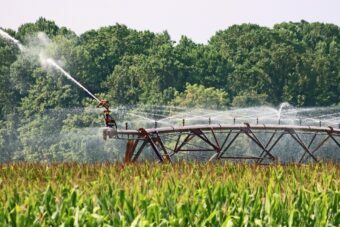The sugar beet harvesting campaign started in mid-August. Producers in the Middle Banat say they don’t remember a worse year than this one. Due to the rotting of many plots, beets will not be harvested this year, and due to low yields, it is certain that the season will end with losses.
Farmer Oliver Paunescu says that he will no longer sow sugar beet, although he and his brother have been producing this crop since 2003. So far, he explains, they have never had a worse season.
“This is the worst year in terms of yield and climatic conditions and misunderstanding of sugar mills and everyone else who could influence the situation in production. There is a lot of rot. It is not below 25-30 percent on any plot, and in some places it is 70 percent. At the beginning, the yield was slightly better, about 32-33 tons per hectare, and now it has more than halved. It’s a disaster,” says Oliver Paunescu, a farmer from Tork.
“The yield from the last plot I harvested was 11,569 kilograms per hectare, which is even five times less than usual,” adds our interlocutor.
Because of many rotten fruits, producers are forced to pay pickers. Up to 60,000 dinars per day.
“We asked the sugar mills to bear the cost of the sorters, but nothing came of it. The state also does not say anything. Subsidies might help, but I don’t even know how much they should be in order for us to recover from this year’s production situation,” says Paunescu.
According to a rough calculation, he says, this year there will be a loss of about 700,000 dinars in production alone. To that should be added the costs of the dialer.
“I have my own machinery, so I don’t pay for the service, only the fuel, and I’m at a loss again. Those who pay for the extraction service are in even bigger trouble. Here in Tork, not a single producer has a good turnip this year. We can rule out mistakes in production, because we don’t all have the same agricultural equipment, we didn’t all use the same preparations, so let’s say we all made mistakes”, explains this farmer.
Julski preocret
Even a month and a half ago, he says, it was certain that good yields could not be expected.
“It is unclear to me that the sugar mills did not start the campaign back in July. Regardless of the fact that then the yield would not be great, there would certainly be less rotting, so we would not have the costs of picking. Maybe we should pay off the debt,” says Paunescu.

“Even though I will remain in debt to the sugar factory, it doesn’t occur to me to sow more beets. If I can, I will reschedule that debt or I will pay through other goods or I will pay them every year into the account. Most likely, the machine we have will also go to ads. We will see if there will be interested buyers. We all have loans and are in debt,” adds our interlocutor.
And Vojislav Cvejić says that the sugar beet looked beautiful until July, but that it died because of the heat.
“We started harvesting turnips a month earlier than last year. The yield is a disaster. On 30 percent of the surface, I won’t have anything to remove at all, because everything is dry. In the parts where it can be extracted at all, the maximum yield is 2.5 to 3 wagons per hectare”, explains Vojislav Cvejić, a farmer from Zrenjanin.
Compared to last year, the crop on his plots is more than halved.
“Last year, for example, at the start I had a yield of 7 wagons per hectare, and at the end, because the extraction was prolonged until December due to rot, the yield dropped to four wagons. In normal years, the average yield is about 6 wagons per hectare,” says our interlocutor.
Bankruptcy is on the horizon for him as well, he says.
“The investments are huge. So far, the sugar factory has followed us in this and we have done everything as they requested. All treatments, all protection were done. I have 100 hectares under my belt, which is half of the total area I work on. If someone does not come to meet me, I will be at a deep disadvantage. And I don’t see anyone coming out to meet me, because they followed me from the sugar factory with raw materials, they gave me part of the money on account. I don’t see the light at the end of the tunnel at all,” explains Cvejić.
The root of the problem is yours
As stated on the website of the Forecasting and Reporting Service, the Banat paori had the last good yield of sugar beet four years ago. In 2022, due to the presence of beet root rot, the yields were at the average level, while last year there were big problems with gum and rot, so the yields were lower.
This year, according to the website of this service, a large percentage of rubbery beet roots was observed in crops where there was no treatment with insecticides, where insecticide treatments were not carried out at the right time and where there was a poor choice of insecticides to control cicadas. The percentage of plants with rubbery symptoms is significant, but it is lower compared to last year, as is the percentage of roots with symptoms of carbonaceous root rot.

“A serious problem on the terrain of the Middle Banat is the appearance of turnip root lice, which had favorable conditions for reproduction during the summer months, and the damage is especially great in dry farming. The cause of such an intense occurrence of this pest is, in addition to favorable weather conditions, the presence of weeds on the plots, primarily ash and sedge, which are also hosts to this pest. In our region, the last major attack of this pest was recorded in 2017,” the report states.
Favorable for beet producers this year is the earlier start of beet harvesting, which started already in mid-August.
“A longer crop residue on plots, especially in dry farming, would be disastrous for the yield and quality of beets. According to current data, the digestibility of beets ranges from 14 to 17, and the yields of beets extracted so far are around 20 tons in dry farming conditions and up to 55 tons in irrigated conditions,” says the PIS website.
In the coming period, experts say, the cultivation of sugar beet should be approached in a planned manner. First of all, you should consider whether this production is possible in dry farming conditions. Of the other factors, it is very important to choose the plot, respect the crop rotation, tillage of the land, choice of pre-meadows, introduction of nutrients, choice of assortment.
Also, it is of great importance to monitor and inspect crops during the entire growing season and to know the biology of pathogens and the development cycle of pests for the purpose of timely application of chemical protection measures and proper selection of pesticides.
Source: RTS
Source: energetskiportal.rs


